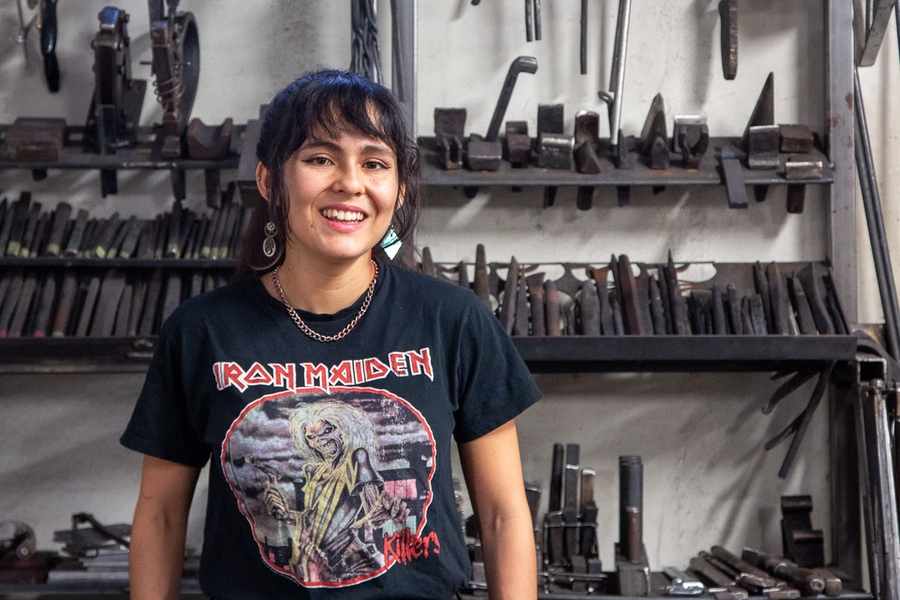Turning a problem upside down comes naturally to senior Amber Velez. She’d trained in trapeze and aerial circus arts for several years, but buying her own circular aerial hoop, called a lyra, was prohibitively expensive.
Instead, as a sophomore, Velez decided to make an affordable lyra herself in a lab on campus. There, staff showed her how to use a tube roller tool to form the lyra’s curved shape. “MIT is a community where everyone is generally very willing to help everyone else,” she discovered there.
Next, she took an introductory metalsmithing course at the Merton C. Flemings Materials Processing Laboratory. After passing a safety test, Velez had free rein to experiment independently in the popular space where students have been forging since 1892. At a school known for pioneering the next technical advances, she forged a sword with a dragon hilt using ancient technology over simple open flame.
Velez moves her lyra between favorite spots on campus, suspending it from columns or trees. “More importantly than teaching you how to make things at MIT, you learn that you have the ability to gain the skills to figure out what you want to do and to make it happen,” she reflects.
A creative approach
After taking a gap year backpacking through Europe and gathering her thoughts, Velez arrived at MIT with a plan. Growing up in Tucson, Arizona, she watched helplessly as climate change hit the surrounding Sonoran Desert hard. She wanted to make a difference through activism, STEM studies, and writing fantasy fiction about how the world could be different and better.
After assembling an engine by hand in an introductory mechanical engineering (MechE) course, she declared her first major and forged a career path. She explains, “I love making things — and that was something I had never realized until coming to college and trying engineering.” Her research focuses on clean energy and decarbonization.
Velez built her second major by hand, too. Creative Writing in History is an interdisciplinary program sponsored through the School of Humanities, Arts, and Social Sciences (SHASS).
Velez took three history classes each semester of her sophomore year before realizing she had accumulated enough credits for a major. When she learned that a history thesis would be the capstone requirement, Velez decided that she would prefer to do a creative writing thesis instead — and fold in some literature courses, as well.
“Activism and politics, for me, have always been grounded in history. I enjoy setting my fantasy in historical periods,” she says. After submitting some paperwork with the support of a faculty sponsor, she received approval from the SHASS registrar. “The process was very straightforward.”
Since then, Velez has taken three courses with her thesis advisor, Joaquin Terrones, including 21L.504 (Race, Gender, and Secret Identities in U.S. Superhero Comics). She says, “His classes have made me think a lot about representation in fiction and how I want to contribute toward it.”
Velez’s thesis will comprise a debut collection of short stories in the fantasy genre. Each piece is based in the Sonoran Desert at different periods in history — some of them imagined. “It’s the only place in the world with really tall cacti that have arms,” she says, visibly excited to talk about the unique, occasionally otherworldly environment.
She’s seen her writing come together with MechE in surprising ways that have the potential to effect change. Velez says, “I study history to understand what needs to be changed, and I write about our world and the ways it can be better. That guides where I apply my MechE skills, into sustainable energy. On the flip side, my understanding of technology contributes to how I imagine fictional worlds and innovations.”
Sharing her story
Through her role as a student blogger for MIT Admissions, Velez discovered a community of writers. She started blogging in her first year. “It’s been a really cool playground to see myself mature in,” she reflects. “Coming in as a Latina student and a minority, I put a lot of pressure on myself to show people back home that I deserve to be here and not give anyone fodder to think otherwise.”
Later that first year, when she enrolled in an advanced physics class without first fulfilling the prerequisite coursework in differential equations, and struggled, that fear ultimately melted away.
She recalls, “This class was going badly, my ego was suffering, and I was panicking. I wrote this really passionate blog post about dropping the class and prioritizing learning material over my own pride.”
It was a brave and honest piece, and the community of MIT bloggers and her readers rallied around her in support.
In the process, something in Velez shifted and strengthened.
Now, she says, “I’m writing for young high school girls or Latinx students, and I am showing them that you don’t need to be perfect; you just need to be pushing yourself and learning.”











